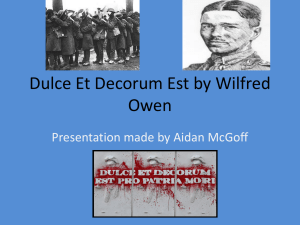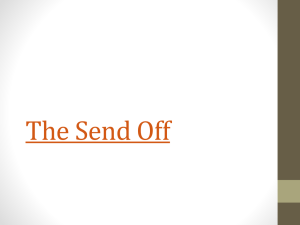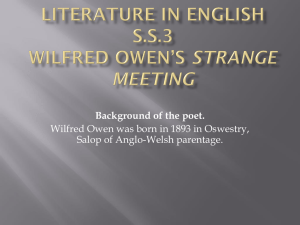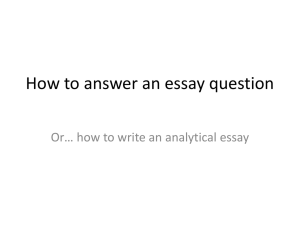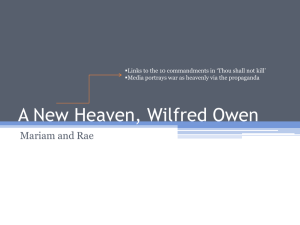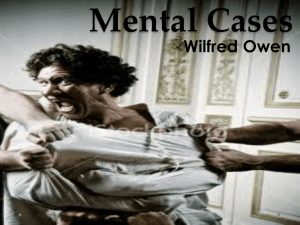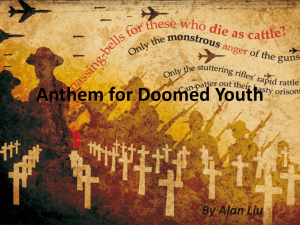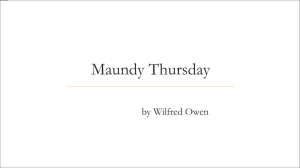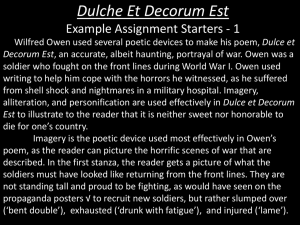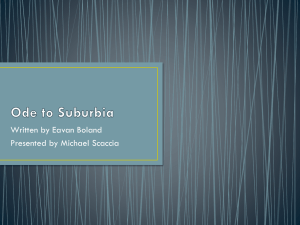Anthem for Doomed Youth
advertisement
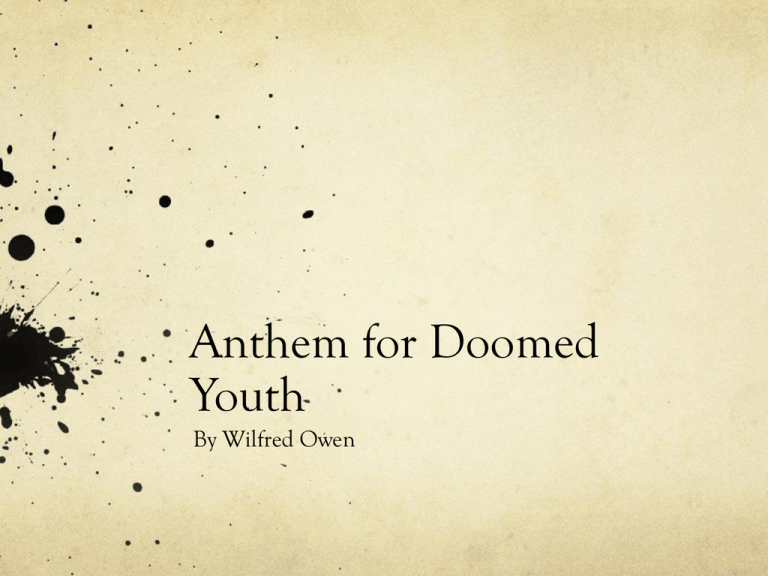
Anthem for Doomed Youth By Wilfred Owen Anthem for Doomed Youth What passing-bells for these who die as cattle? - Only the monstrous anger of the guns. Only the stuttering rifles' rapid rattle Can patter out their hasty orisons. No mockeries now for them; no prayers nor bells; Nor any voice of mourning save the choirs, The shrill, demented choirs of wailing shells; And bugles calling for them from sad shires. What candles may be held to speed them all? Not in the hands of boys, but in their eyes Shall shine the holy glimmers of good-byes. The pallor of girls' brows shall be their pall; Their flowers the tenderness of patient minds, And each slow dusk a drawing-down of blinds Wilfred Owen 18 March 1893 – 4 November 1918 An English poet and soldier, one of the leading poets of the First World War. Owen fought in World War I and wrote this poem while in a hospital recovering from shell shock. Wilfred Owen was born the eldest of four children in a house near Oswestry in Shropshire called Plas Wilmot on 18 March 1893, of mixed English and Welsh ancestry. Lived in a comfortable house owned by his grandfather but, on his death in 1897, the family was forced to move to lodgings in the back streets of Birkenhead. He was educated at the Birkenhead Institute and at Shrewsbury Technical School (now The Wakeman School), and discovered his vocation in 1903 or 1904 during a holiday spent in Cheshire. Owen was raised as an Anglican of the evangelical school, and in his youth was a devout believer, in part due to his strong relationship with his mother, which was to last throughout his life. His early influences included the 'big six' of romantic poetry, particularly John Keats, and the Bible. Shortly after leaving school in 1911, Owen passed the matriculation exam for the University of London, but not with the first-class honours needed for a scholarship (his studies suffered as Owen mourned the loss of his uncle and role model, Edgar Hilton in a hunting accident) which in his family's circumstances was the only way he could have afforded to attend. In return for free lodging, and some tuition for the entrance exam, Owen worked as lay assistant to the Vicar of Dunsden near Reading and as a pupil-teacher at Wyle Cop School. He then attended classes at University College, Reading (now the University of Reading), in botany and later, at the urging of the head of the English Department, free lessons in Old English. His time spent at Dunsden parish led him to disillusionment with the church, both in its ceremony and its failure to provide aid for those in need. Prior to the outbreak of World War I, he worked as a private tutor teaching English and French at the Berlitz School of Languages in Bordeaux, France. There he met the older French poet Laurent Tailhade, with whom he later corresponded in French. On 21 October 1915, he enlisted in the Artists' Rifles Officers' Training Corps. For the next seven months, he trained at Hare Hall Camp in Essex. On 4 June 1916 he was commissioned as a second lieutenant (on probation) in The Manchester Regiment.[2] Owen started the war as a cheerful and optimistic man, but he soon changed forever. Initially, he held his troops in contempt for their loutish behaviour, and in a letter to his mother described his company as "expressionless lumps". However, Owen's outlook on the war was to be changed dramatically after two traumatic experiences. Firstly, he was blown high into the air by a trench mortar, landing among the remains of a fellow officer. Soon after, he became trapped for days in an old German dugout. After these two events, Owen was diagnosed as suffering from shell shock and sent to Craiglockhart War Hospital in Edinburgh for treatment. It was whilst recuperating at Craiglockhart that he met fellow poet Siegfried Sassoon, an encounter which was to transform Owen's life. After a period of convalescence in Northern Ireland, then a short spell working as a teacher in nearby Tyne castle High School, he returned to light regimental duties. In March 1918, he was posted to the Northern Command Depot at Ripon.. A number of poems were composed in Ripon, including "Futility" and "Strange Meeting". His 25th birthday was spent quietly in Ripon Cathedral. After returning to the front, Owen led units of the Second Manchester's on 1 October 1918 to storm a number of enemy strong points near the village of Joncourt. However, only one week before the end of the war, whilst attempting to traverse a canal, he was shot in the head and killed. The news of his death, on 4 November 1918, was given to his mother on Armistice Day. For his courage and leadership in the Joncourt action, he was awarded the Military Cross, an award which he had always sought in order to justify himself as a war poet, but the award was not gazetted until 15 February 1919. Owen is regarded by historians as the leading poet of the First World War, known for his war poetry on the horrors of trench and gas warfare. Owen was killed in action on 4 November 1918 (aged 25) during the crossing of the Sambre–Oise Canal, exactly one week (almost to the hour) before the signing of the Armistice and was promoted to the rank of Lieutenant the day after his death. His mother received the telegram informing her of his death on Armistice Day, as the church bells were ringing out in celebration. He is buried at Ors Communal Cemetery Critical Review The war imagery in the poem allows the reader to depict the message of the poem along with the notes associated with it. The main imagery in the first stanza is about the sound of war and death and the impacts and effects on soldiers from war. The sounds of war are said to be by critics, ‘only sounds because in the trenches at war it is virtually pitch black.’ The soldiers are unable to see; only hear. The second stanza imagery involves sight. "candles" and "holy glimmers". The topic of sight can describe the realisation of the civilians back at home have no idea of what is happening until the see it for themselves. Especially with the emotive language "Not in the hands of boys but in their eyes", also showing that no one can understand what they felt; what they saw. The fact that the soldiers who died in the war meant that they would not get a proper funeral because they died overseas. This brings sadness to the families back in their country. The last line in the stanza has a special effect "a drawing-down of blind". Not only can just be the traditional mark of respect when people die but it can also describe the families of the dead soldiers closing their blinds; turning their backs on the war. All of this allows the reader to empathise with the soldiers with their lifestyle and hardships they had to endure. Allowing them to pay their respects to the many brave people’s sacrifices that may have been forgotten in the war. Analysis of Language Wilfred Owen uses a lot of comparisons comparing a typical funeral to a death on the battle field, For example, he compares the church bells with the noise of a gun-fire; the prayers with the rapid rifle fire; the choirs with the wailing of shells; the candles head by altar boys with the lights of the sky reflected in the dead eyes of the soldiers. grotesque images are used in order to show how inhumane war is, for example, in the first line, he uses a simile to show that soldiers are no more important than cattle which are led to the slaughter house without felling (“What passing-bells for these who die as cattle?”). Owen uses these comparisons so that the reader can relate more easily to the poem and realise that war is a terrible experience that no one should have to go through. Analysis of Structure Related to the structure of the poem, we can say that this poem is a variation of the Elizabethan sonnet. Owen has divided the fourteen lines of this sonnet into two stanzas, the break coming at the end of the line 8. As is the case with the Elizabethan sonnets, this poem has ten syllables of iambic pentameters, because there are five feet, and each foot contains a short syllable followed by a long one. The rhyme scheme is ABAB CDCD EFFE /GG, which differs slightly from the classical Elizabethan sonnets, whose rhyme scheme is ABAB CDCD EFEF / GG. By using a sonnet for the structure of his poem, Wilfred Owen creates irony, because the sonnets normally convey love, and this poem is sort of anti-love. The young soldiers have to spend their time in the trenches. So, their lives are wasted and the lives of their loved ones at home are also ruined. Through the tone, the poet depicts a strong anger at the futility of war, because he is an anti-war poet. Analysis of Title (The Anthem for Doomed Youth) Anthem – a song of praise, devotion or patriotism. The use of the word ‘anthem’ is ironic when it is used with the word ‘doomed’, which means certain demise because anthems are meant to be songs of praise. It also creates irony because Owen was an anti-war poet and didn’t support his countries decision to go into war, yet anthems are meant to be patriotic songs. Assonance of ‘doomed youth’ creates a long, melancholic tone. The word ‘youth’ highlights that war is wrong. This goes against the natural idea that the ‘youth’ are meant to be protected. Instead, they are being sent to war; ‘doomed’ to death. Stanza one vs. Stanza two In the first stanza, Owen uses a lot of violent death imagery. This represents the dead men’s first funeral on the battlefield. With ‘wailing of choirs’ and ‘stuttering rifles’, the funeral is loud, irreverent (‘no prayers, no bells’) and indifferent ( ‘No mockeries....mourning save the choirs, -’) Lots of very loud sounds and violent actions in stanza one .e.g. ‘Stuttering rifles’, ‘wailing shells’, ‘bugles calling’ etc. In the second stanza, the family receive the body of their loved one that died in battle. This funeral dramatically contrasts with the funeral in stanza one. Their is no onomatopoeia in this stanza and this stark silence creates an eerie, sombre tone. This change in tone can represent the shell shock that inexperienced men in war go through. At the time that Wilfred Owen wrote this poem, he was shell shocked and staying at hospital recovering. FLIRTY Questions Describe the Tone of this poem Identify the rhyme scheme used and explain its significance. How is the first stanza different from the second? Give Examples. How it the theme of war and death presented? What is the effect of alliterations in this poem? Explain each given example. Describe the effect of personifications used. What kind of imagery has the poet used? How does this convey the poets ideas? Describe Owen’s views on war. How do they differ/how are they similar to our views today? Further Reading Johnny Got His Gun – Dalton Trumbo Dulce et Decorum est – Wilfred Owen In Flanders Fields – John McCrae Base Details – Siegfried Sassoon

